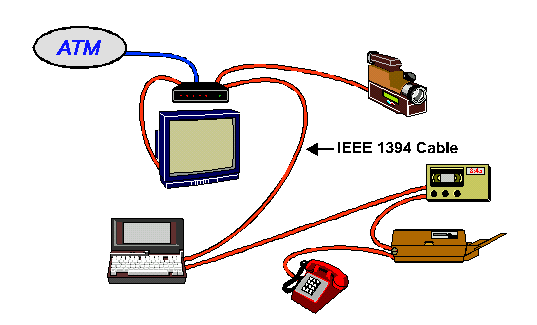
The IEEE 1394 high-speed serial bus promises to revolutionize the transport of digital data for computers and for professional and consumer electronics products. By providing an inexpensive non-proprietary high-speed method of interconnecting digital devices, a truly universal I/O connection has been created. Its scalable architecture and flexible peer-to-peer topology makes IEEE 1394 ideal for connecting devices ranging from printers and hard drives to digital audio and video hardware with real time processing requirements for on-time multimedia.

IEEE 1394 is a standard, platform-independent solution. Its features represent an evolutionary improvement over current I/O interfaces and provides connectivity solutions for many markets. Legacy I/O bridges attach serial and parallel interfaces to 1394. ASCII SCSI-3 provides a migration path for parallel SCSI to move to IEEE 1394.
IEEE 1394 can interface with the higher layers of the new parallel port standard, IEEE 1284. Although IEEE 1284's 4 to 32 Mbps transfer rate is lower than that of 1394, 1284 finds application in printer connectivity since it is backward compatible with the existing Centronics parallel port.
IEEE 1394 devices of differing transport rates may be interconnected, allowing backward compatibility with devices having slower transport rates. This feature allows 100 Mbps devices purchased today to operate properly in future bus configurations involving 200 and 400 Mbps devices.
The IEEE 1394 serial bus is:
 a digital interface: there
is no need to convert digital data into analog and tolerate a
loss of data integrity
a digital interface: there
is no need to convert digital data into analog and tolerate a
loss of data integrity
 physically small: the thin
serial cable can replace larger and more expensive interfaces
physically small: the thin
serial cable can replace larger and more expensive interfaces
 easy to use: there is no
need for terminators, device IDs, or elaborate setup
easy to use: there is no
need for terminators, device IDs, or elaborate setup
 hot pluggable: users can
add or remove 1394 devices with the bus active,
hot pluggable: users can
add or remove 1394 devices with the bus active,
 inexpensive: priced for consumer
products
inexpensive: priced for consumer
products
 scalable architecture: may
mix 100, 200, and 400 Mbps devices on one bus
scalable architecture: may
mix 100, 200, and 400 Mbps devices on one bus
 flexible topology: support
of daisy chaining and branching for true peer-to-peer communication
flexible topology: support
of daisy chaining and branching for true peer-to-peer communication
 fast: even multimedia data
can be guaranteed its bandwidth for just-in-time delivery
fast: even multimedia data
can be guaranteed its bandwidth for just-in-time delivery
 computers
computers
 audio, image, and video products
for multimedia
audio, image, and video products
for multimedia
 printer and scanner products
for imaging
printer and scanner products
for imaging
 hard disks, especially hard
disk Raid arrays
hard disks, especially hard
disk Raid arrays
 digital video cameras, displays,
and recorders
digital video cameras, displays,
and recorders
IEEE 1394 is currently defined by ANSI draft standard P1394. The IEEE Standards subgroup concerned with 1394 successfully closed its ballot on 1394 in December 1994 with formal 1394 approval anticipated in the second quarter of 1995.

© Copyright Skipstone, Inc. 1995. All rights reserved.
Return to the Skipstone home page.